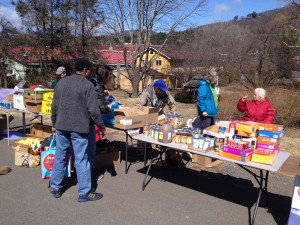Take $1 – Leave $1
The young musician’s sign said it all:
TAKE $1
LEAVE $1
She sat on the sidewalk in front of Houst the other day, with her guitar box open. True to Woodstock tradition, she was singing for tips. Her sign, her posture, her music really resonated with me. I really feel that we are now fast approaching the point in our country where our residents are divided into two groups:
those who use pantries, soup kitchens
those who do not use pantries, soup kitchens
So, that puts us in the Take $1 – Leave $1 lifestyle.
Food pantries and soup kitchens, through the food distribution process work relentlessly to end hunger. Most people working in pantries or soup kitchens are volunteers who understand they offer hope and sustenance to a community of people living with and affected by hunger and, in some cases, homelessness.
Any amount you can spare will help make the pantry or soup kitchen you support a better place. Please send a donation today. Your gift will make a difference in the lives of people who have little and need a lot. Take $1 – Leave $1
Thank you in advance for your generosity.
Thurman Greco
Thank you for reading this blog. The story is true. The people are real.
Please refer this article to your preferred social media network.
Don’t forget to join the email list.
5 Important Things You Need to Know About SNAP
“Hunger and income inequality is probably the single biggest issue facing this country.” – Susan Zimet
When you use SNAP, you don’t just get much needed food for your household. When you use SNAP, you create a ripple effect of money for your community. You can use your SNAP card with pride knowing how your purchases will benefit your area.
Here’s how it works: SNAP is federal money. When you use your SNAP card at a local supermarket, you bring it into your community. The grocer uses the money to benefit the local grocery store. This purchase strengthens local businesses.
Are you in a household with senior/disabled members? If so, you may still qualify for SNAP even if you have a higher income. SNAP works for individuals, couples, and families.
Are you paying mandated child support? If so, this money you use to pay child support is not counted toward your income.
You can work and still qualify for SNAP, stretching your food budget every month. When you use SNAP, you more easily afford the nutritious foods you and your family need.
You can shop at a food pantry and still qualify for SNAP.
SNAP can be an important addition to you and your household budget. Apply for this benefit today to help yourself, your household, and your community. How cool is that?
Thanks for reading this blog.
The story is true. The people are real.
Don’t forget to join the email list.
Please refer this article to your preferred social media network and to anyone you know you may benefit from SNAP but is not using it.
Thurman Greco
My Story and the 9 Truths I Discovered
I began my life changing journey fighting hunger on a cool autumn Thursday in Woodstock, New York in 2005 where I volunteered for the first time at the local food pantry.
I was assigned a shift with Marie Duane. I drove over to the Woodstock Reformed Church, parked my car behind the buildling and cautiously walked in. I had never been to the pantry before.
I entered the empty hallway and found the pantry on the right. I walked into the room and there it was: a small space, actually, about 12′ by 16′. Each wall supported a set of metal shelving units. Each unit stood about 6′ high and 3′ deep with 4 shelves. Most of the shelves were empty. A few shelves had some food:
cereal
tuna
soup
peanut butter.
There was a little handwritten note in front of each display:
person: 1 item, family: 1 item.
There may have been other items on shelves but I don’t remember them.
A small table stood in the center of the room. A metal folding chair was placed in front of each window.
We sat in the chairs, Marie and I, and chatted as people trickled in. We discussed the usual: weather, gardening, knitting, decorating the alter at St. Gregory’s Episcopal Church.
“Hi. How are you? Will you please sign your name here?” Each shopper signed in and noted the number of adults, seniors, and children in the household. After signing in, the person walked around the room selecting from the cereal, peanut butter, tuna, and soup. The selected food was placed on the table and bagged to take home, wherever or whatever that was.
On this morning, not blessed with any psychic knowledge, I was totally unaware of experiences waiting for me in the pantry. Never in my wildest thoughts did I envision the hall filled with hungry people, the tiny room packed with fresh produce and jammed with shoppers.
Nor did I for 1 moment ponder the push back I would experience as the number of hungry seeking food grew. Within a few short years, this 2 dozen single homeless men – mostly Woodstock’s colorful characters – had swelled (due to a tanking economy) to over 300 people weekly. This number finally approached 500 people weekly before it was all over.
Now, in the autumn of 2015, our stock market experiences numerous “corrections”. I realize I learned some things over the years which, for me, are ground truths about the pantry.
Feeding the hungry with dignity is the most important thing.
Single homeless men are now far outnumbered by members of the Struggling Class, households of working people holding down 2 and 3 jobs just to pay the rent and buy the gas to get to work.
The 3 most hot button words in the English language are food, sex, and money. These 3 words are concerned with a person’s core beliefs, emotions, and spiritual attitudes. Food and money, or the lack thereof, loom large in pantries.
The sidewalks in our communities and cities have become wards of untreated mentally ill people. In our great nation we don’t hospitalize or otherwise treat many of our mentally ill. Instead, they they are incarcerated.
Some of these untreated mentally ill happen to be homeless. Homeless is not a category of people. It’s just a situation that happens. It can happen to anyone.
The 50+ senior population has many who lack enough $$$ for food and are largely a silent group. The bottom line is this: When our grandparents don’t get enough to eat, they often get sick.
I’m seeing a whole generation of children who have never been inside a grocery store.
Shoppers at our pantry can get a 3-day supply of food weekly. Their job is to make it last 7 days. Many share this food with a pet. Often, the only thing a person has left from a prosperous past is the dog.
The most difficult thing I see in the pantry is a Korean War vet getting food. Something I just can’t understand is how a person who served in a very brutal war, and subsequently spent an adult life working and paying taxes should have to be in a food pantry line in his old age.
Much of the food available to the hungry in food pantries is diverted from its trip to the landfill.
There is absolutely no excuse for anyone in our great nation to go hungry.
Thank you for reading this blog. The story is true. The people are real.
Please refer this article to your preferred social media network. Share this story with friends or relatives who might be interested.
Don’t forget to join the email list.
Thurman Greco
Breakfast in the Classroom? 8 Reasons why it’s Important
1. Children learn better. Studies show children who eat breakfast in the classroom score better at math, reading tests. Breakfast helps students pay attention to the teacher. Their memory is improved. Children behave better if they are not hungry.
2. Breakfast in the classroom helps fight childhood obesity. School meals follow nutritional guidelines. Breakfast is more nutritious than it might otherwise be.
3. Not all children eat before coming to school. They may not have an appetite when they first wake up. There may not be nutritious food in the home. They may be too busy to eat. That means they lack the energy and nutrients they need to perform at their best throughout the day.
4. Breakfast in the classroom results in better attendance. Children living in households where breakfast is not available are tardy less often and spend less time in the nurse’s office when they receive breakfast in the classroom.
5. A consistently served nutritional breakfast in the classroom develops healthy eating habits throughout life. Children who eat breakfast in the classroom have a better nutritional intake than those who don’t. These are habits which can be carried into adulthood.
6. When breakfast is served in the classroom, every student participates. There are no obstacles such as bus schedules, cafeteria location, social stigma. This fosters a sense of community, something badly needed for children growing up in food insecure households.
7. Breakfast in the classroom is not a lot of work. A well planned breakfast program only takes about 15 minutes and can be part of routine activities. The whole project can be a collaborative effort operated by the food service staff, the and the teacher. This will build a sense of community.
8. Breakfast in the classroom decreases the risk of food insecurity. Breakfast in the classroom is important for the student who doesn’t have enough food to eat in the home.
Thank you for reading this blog.
I’ll be publishing articles on this blog less frequently while I’m preparing my reflexology book for publication. Thanks in advance for your patience.
Please refer this article to your preferred social media network.
Don’t forget to join the email list..
Thurman Greco
Writers’ Boot Camp Inspiration
I’ve been inspired by the Writers’ Boot Camp experience to knuckle down and finish the reflexology book…AT LAST!
So, I’ll be posting on the hunger/food pantry blog every other week for the next few weeks. I hope you are not inconvenienced by this.
Thank you for your patience and your support.
Thank you for reading this blog.
Please refer this article to your preferred social media network.
Don’t forget to join the email list.
Thurman
http://www.reflexologyforthespirit.com
http://www.goodmorningwoodstock.com
Libraries – and the Hungry
“Hunger and income inequality is probably the single biggest issue facing this country.” – Susan Zimet
LIBRARIES ARE EXTREMELY IMPORTANT TO A TOWN, TO A COUNTRY.
Libraries are equal opportunity events offering information, learning, culture for any and all who enter. They also offer an opportunity to get in out of the rain, snow, heat. As far as I can tell, it’s easier to get into a library than it is to get into a lot of pantries.
For one thing, I don’t think you have to prove where you live to get into a library. There may be libraries out there that require proof of address, and other identification but I don’t know about them. (If you know of a library requiring identification or proof of residency to enter, please let me know. I don’t want to be wrong about that.)
Libraries are important to a community. The most important thing I carry in my wallet is my Woodstock Free Library Card. I never have to show it to anyone to use the library. I just walk in the door and all this wonder, this knowledge, this information is available to me…for nothing. But, for some reason, I feel that it’s important to carry it.
At the Woodstock Free Library, a person can even take his/her dog if it’s on a leash.
As soon as I walk in the door, I see the computers. And, of course, they are available to everyone. These computers are sooo important to those of us who are in a situation where there are only funds for rent and gas. For those in the “broke” category, a computer is out of the question.
For those in the homeless category, library computers are even more important because they are a homeless person’s ticket to communication with the outside world…especially offices such as Department of Social Services, Office of the Aging. For a homeless person seeking shelter, they are invaluable. For a housed person seeking a larger or less expensive apartment, they are necessary. A job seeker cannot get hired these days without access to a computer.
We can all get an email address quickly and cheaply at Gmail.
I’ve been connecting with area libraries recently to book a series of speeches I’ll be giving this year. Libraries in communities all around Woodstock are in such wonderful condition. They are right in town in beautiful buildings. Ample parking is available. The libraries are open for extended hours.
They have bathrooms – a luxury that we all need.
I mention these things in a blog about hunger and food pantries because, in a perfect world, I would have a library and a pantry in the same building. It only makes sense really. After all, all the people I see in the pantry are also all the people I see in the library.
Thanks for reading this blog.
Please refer this article to your preferred social media network.
Don’t forget to join the email list.
Thurman Greco
Summertime
“What’s happened?” she asked with concern in her voice.
“What do you mean? ” I replied.
“What happened to the people?”
“Oh, that. Well, it’s summer.”
What’s happened is that the faces are often different in the pantry in the summer. When you’re living on the edge, when you’re a member of the Struggling Class, the change of seasons counts for a lot.
People who were too sick to make it to the pantry in cold are now able to make it out. How they manage to make it through the winter is a question for me. These shoppers barely get enough to eat as it is. How do they eat over the winter? Humans are not bears and don’t hibernate. What do these disabled do to survive?
And, yet, we have many in this category.
Some can’t make it to the pantry in the winter because their vehicles aren’t winter worthy. Beyond a certain temperature, the cars just don’t work. Then, as spring rolls around, they manage to get them running again to drive to the pantry during the warmer months.
Making it to the pantry in the winter is really difficult for the homeless. Truthfully, I don’t know how some of these homeless live in the winter. How they keep from freezing to death seems to me to be a miracle.
We lose some shoppers also. In the winter, men visit the pantry regularly because they don’t have work. Then, as the weather gets warmer, they find jobs and can’t come to the pantry because they’re working when the pantry is open.
We always miss these guys because they are good volunteers and really make a contribution to the pantry during the cold months.
One staple which carries everyone through challenges is peanut butter. Peanut butter is important to everyone in the Struggling Class.
It is important because it:
can be eaten right out of the jar.
needs no refrigeration.
has a long shelf life.
is not necessary to have teeth in order to eat it.
does not have to be combined with another food in order to be palatable.
is nutritious.
does not usually come in a container requiring a can opener.
is not necessary to cook it.
The only hitch to this whole wonderful story about peanut butter is that most of the time, there is no peanut butter in the food pantry.
The only time we are able to get peanut butter in our pantry is when we are having a peanut butter drive. It’s been months since we’ve had a decent amount, or any amount, of peanut butter.
Can you help?
There are 2 ways you can come to our rescue:
Our pantry is open Mondays from 2 to 4 in the afternoon. I’m usually there by 10:00 am.
On Tuesday mornings from 9:00 to 10:00 we are in the pantry packing the take out bags.
If you live/work in the area and want to bring some peanut butter to the pantry, we’re happy to receive it then.
If dropping the peanut butter off at the pantry is not convenient, we’ll be happy to accept your donation and purchase the peanut butter for the pantry. Please send the check to: Reservoir Food Pantry, P.O.Box 245, Boiceville, NY 12412.
We thank you in advance for this generosity. Currently, we serve over 150 households each week. Everyone needs peanut butter.
Peace and food for all.
Thurman Greco
Thank you for reading this blog post.
Please share this article with your preferred social media network.
Don’t forget to join the email list.
















